14 Types of Black Birds in Wisconsin (with Pictures)
Last Updated on
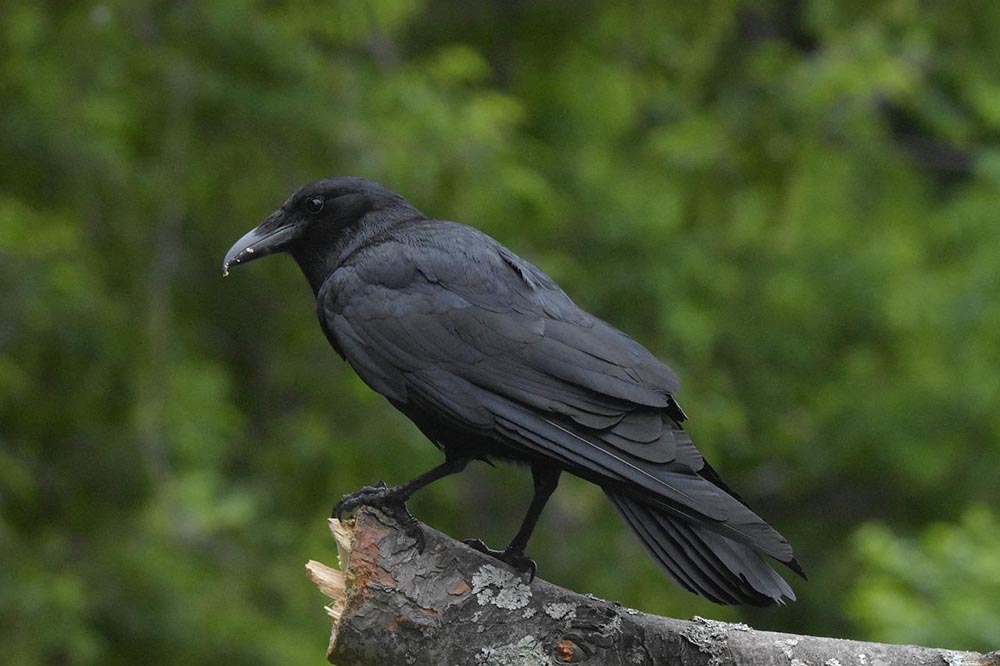
There are “blackbirds,” and then there are “black birds.” The former is a family of 20+ North American birds.1 The latter simply refers to any bird that is black. Learn more about both types of birds, including where you can spot them in Wisconsin.

The 14 Types of Birds That Belong to the Blackbird Family in Wisconsin
1. Red-winged blackbird
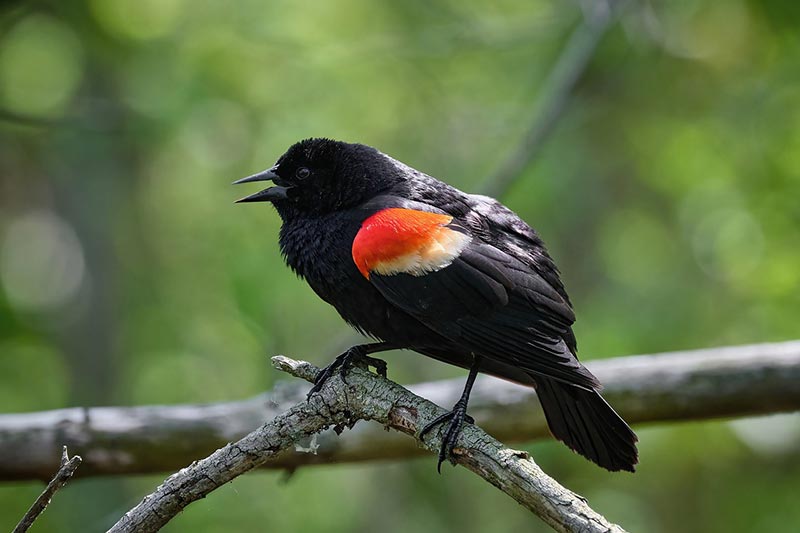
| Scientific Name: | Agelaius phoeniceus |
| Average Clutch Size: | 3 to 4 eggs |
Red-winged blackbirds breed throughout most of Wisconsin. Bird watchers in the state’s far southwestern corner may see them all year long. These birds forage on the ground for insects and seeds but may also eat berries and small fruit. It’s common for male red-winged blackbirds to have more than one mate at a time.
This leaves most of the nestling care to the females, but the males will pop in to help with feeding. Young blackbirds leave the nest around two weeks after hatching. They build their nests in dense marshes, bushes, and grass. These brave and territorial birds don’t hesitate to attack larger birds that threaten their nests.
2. Bobolink

| Scientific Name: | Dolichonyx oryzivorus |
| Average Clutch Size: | 5 to 6 eggs |
These migratory birds come to Wisconsin during the summer to breed. Male bobolinks have a striking white patch on the back of their heads, which makes them easy to spot. Mating pairs take great care to hide their nests amongst dense grasses. Bobolinks don’t spend much time parenting, and the birds only have one brood each year. The nestlings leave before they can fly, sometimes as early as 8 days old. You can spot flocks of bobolinks foraging for insects, and their diet transitions to seeds and berries when they migrate out of the state.
3. Brown-Headed Cowbird

| Scientific Name: | Molothrus ater |
| Average Clutch Size: | See below |
Brown-headed cowbirds are brood parasites that threaten other avian populations. Females lay their eggs in established nests, often destroying other birds’ eggs in the process. A female can lay up to 40 eggs per breeding season, but neither parent sticks around to feed their nestlings.
Many host birds are tricked into caring for cowbird nestlings, which leave the nest at 10 days old. The National Audubon Society states that over 140 other species are documented as hatching and feeding young cowbirds.2 The bird gets its name because it eats insects that cows disrupt during grazing.
4. Common Grackle
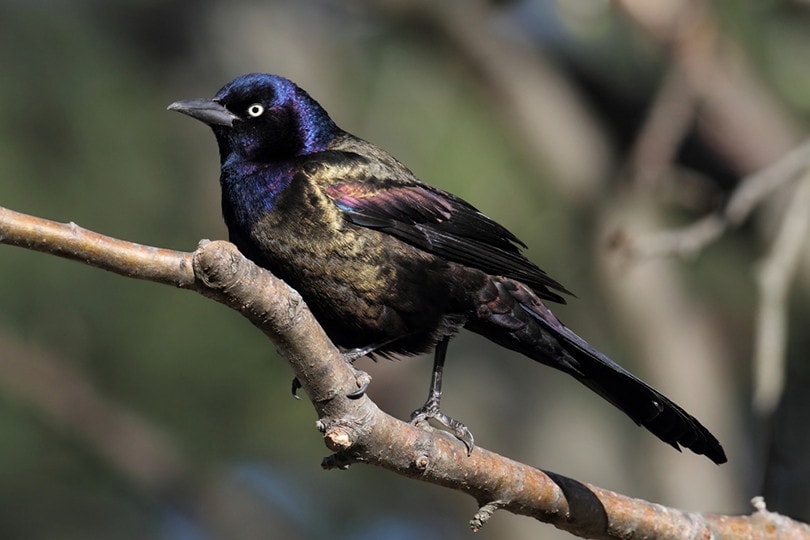
| Scientific Name: | Quiscalus quiscula |
| Average Clutch Size: | 4 to 6 eggs |
If you see an adult grackle up close, you’ll notice its iridescent, shimmering feathers. These birds have a year-round presence along Wisconsin’s southwest Mississippi River shoreline. They breed throughout the state during summer.
Common grackles are not solitary creatures. They nest in colonies and forage in flocks. The females build nests, while both parents play a role in feeding nestlings. Adults have a varied diet that includes insects, small rodents, and other birds’ eggs. They will also eat grains, seeds, and berries.
5. Brewer’s Blackbird

| Scientific Name: | Euphagus cyanocephalus |
| Average Clutch Size: | 4 to 6 eggs |
Most Brewer’s blackbirds breed to the north and west of Wisconsin. However, occasionally flocks will nest and migrate here. The birds are adaptable and can live in most environments.
They often congregate where people are, so don’t be surprised if you spot them in a parking lot or a suburban park. Females build nests, while both parents play a role in feeding nestlings. Young birds leave the nest around two weeks after hatching. The birds eat mainly insects but will feast on berries.
6. Yellow-headed Blackbird
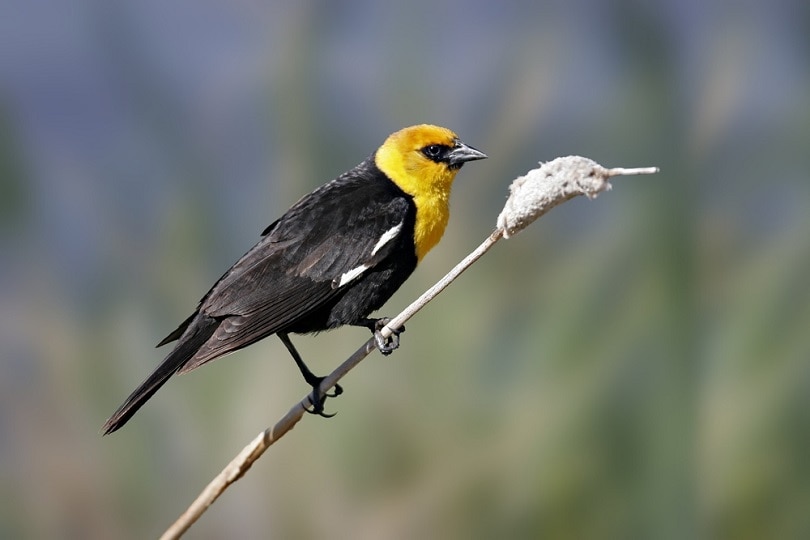
| Scientific Name: | Xanthocephalus xanthocephalus |
| Average Clutch Size: | 4 eggs |
Adult males live up to their name, with vibrant yellow heads. This coloring extends to form a bib-like patch below their necks. Your best chance of seeing the bird in Wisconsin is along the central Mississippi River valley. They will often form large flocks with other blackbird species. Both parents play a role in feeding the nestlings, but male birds are busy during the breeding season, as they often have several mates.
Young birds leave the nest around 10 days old but stay close until they can fly. Yellow-headed blackbirds nest in colonies in marshes, and they forage for insects on open land, often near farms.
7. Rusty Blackbird
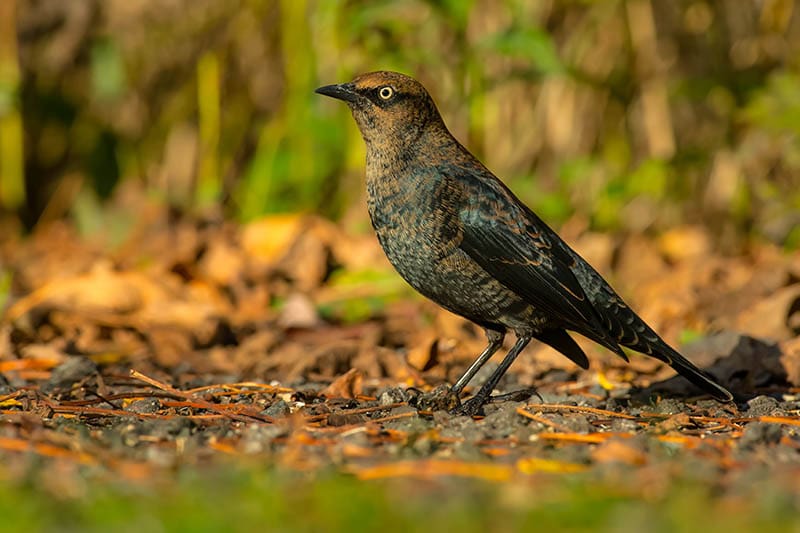
| Scientific Name: | Euphagus carolinus |
| Average Clutch Size: | 4 to 5 eggs |
Seeing this blackbird in Wisconsin is a hit-or-miss proposition. The rusty blackbird breeds in northern Canada and Alaska and occasionally moves into Wisconsin during the winter. They inhabit swamps and bogs far from humans, making it challenging to observe the bird. Rusty blackbirds are both solitary and social.
Pairs often nest in isolated locations, but they also join flocks of other blackbirds when foraging. Young nestlings leave when they are 14 days old. Aquatic insects make up the bulk of their diet, but they will also eat seeds, grains, and berries.
8. Eastern Meadowlark
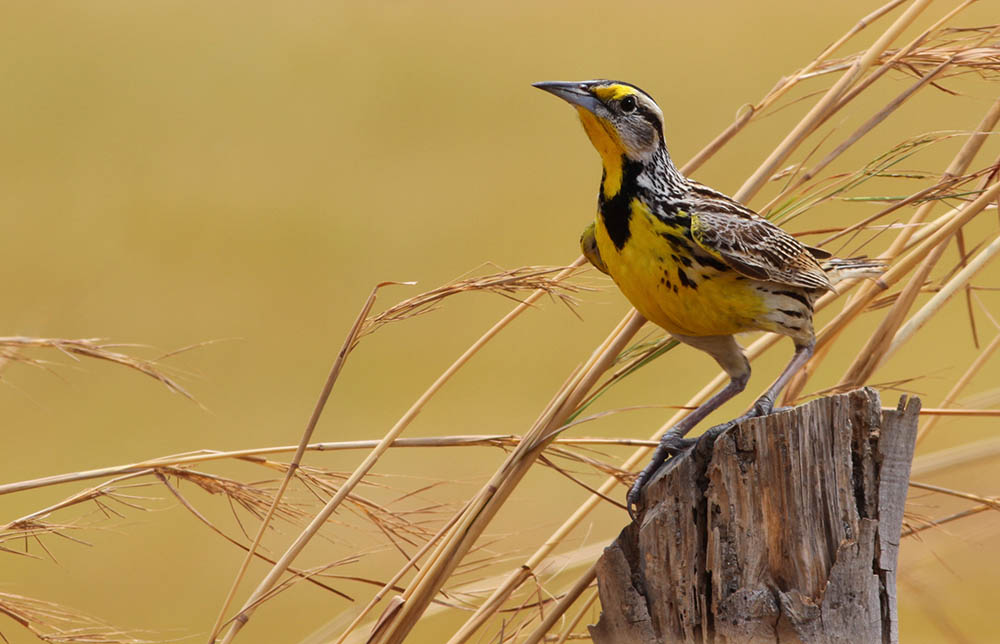
| Scientific Name: | Sturnella magna |
| Average Clutch Size: | 3 to 5 eggs |
Eastern meadowlarks live in the southeastern U.S., but some flocks make their way to Wisconsin during the summer. You might see this bird all year if you live along the Illinois border. Meadowlarks eat insects during the summer, and you may even see one probe the soil with its sharp beaks.
Male meadowlarks can have more than one mate. The birds dine on waste grain and seeds in the winter. While the meadowlark is part of the blackbird family, it’s mostly yellow, brown, and cream. You can quickly identify an adult by the black “V” on its neck.
9. Western Meadowlark
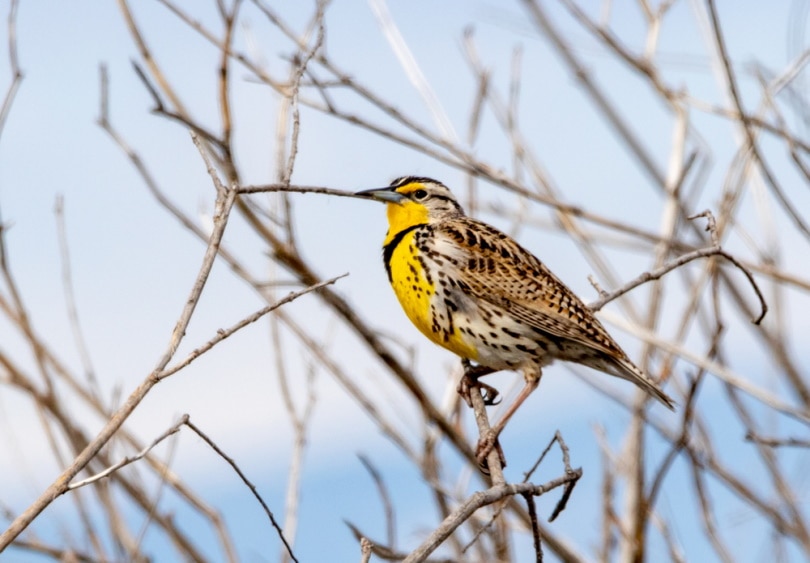
| Scientific Name: | Sturnella neglecta |
| Average Clutch Size: | 3 to 7 eggs |
Wisconsin is one of the states where the Eastern and Western meadowlark ranges overlap. These birds look and behave similarly but have different songs and calls; they are two distinct species and rarely interbreed.
Western meadowlarks come from the southwestern U.S. to breed in Wisconsin. You can see them throughout the state, but populations are concentrated along the southern Mississippi River valley. Western Meadowlarks forage for insects in the summer. They spend the winter in flocks when their diet expands to include seeds and grains.
10. Great-Tailed Grackle

| Scientific Name: | Quiscalus mexicanus |
| Average Clutch Size: | 3 to 4 eggs |
The great-tailed grackle lives in the Southwest but rarely breeds as close as Minnesota and Iowa. The bird makes our list because of a few Wisconsin sightings recorded by Cornell University. Since 2017, the grackle has been seen in Racine and Kenosha. The bird’s range is slowly increasing, so it’s possible there will be more sightings in the state.
Great-tailed grackles live in open and semi-open areas. They are the only birds on our list where both the males and females have multiple mates. The omnivores feed in flocks and eat whatever is available, including insects, seeds, grains, and even other adult birds.

Birds That Are Black, But Not Part of the Blackbird Family
11. Common Raven
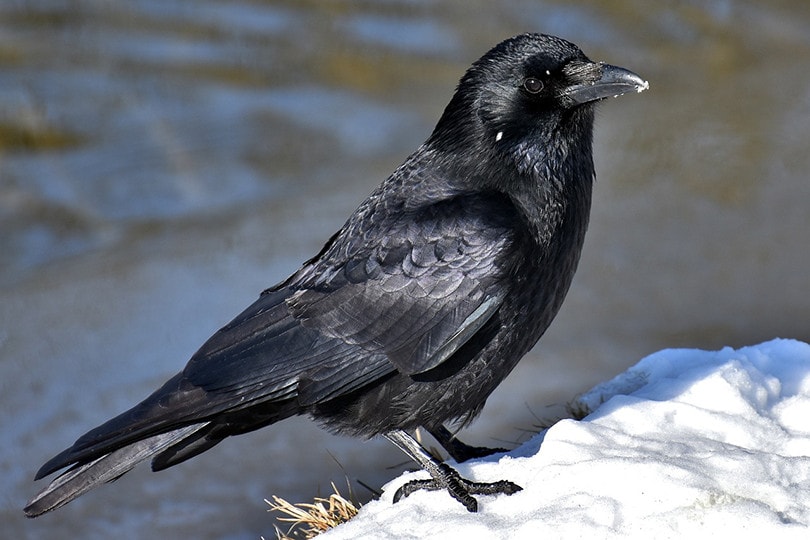
| Scientific Name: | Corvus corax |
| Average Clutch Size: | 4 to 6 eggs |
Ravens belong to the crow, magpie, and jay family. The birds live in northern Wisconsin throughout the year. It’s not difficult for common ravens to find food, as they’ll eat virtually anything. They hunt for insects, rodents, amphibians, and other birds’ nestlings and eggs. Ravens will also eat carrion and pick through garbage.
They differ from most other birds on our list because males and females build their nests. Both parents also play a role in feeding the nestlings. Young birds stay in the nest for a relatively long time, not leaving until they are 6 weeks old.
12. American Crow
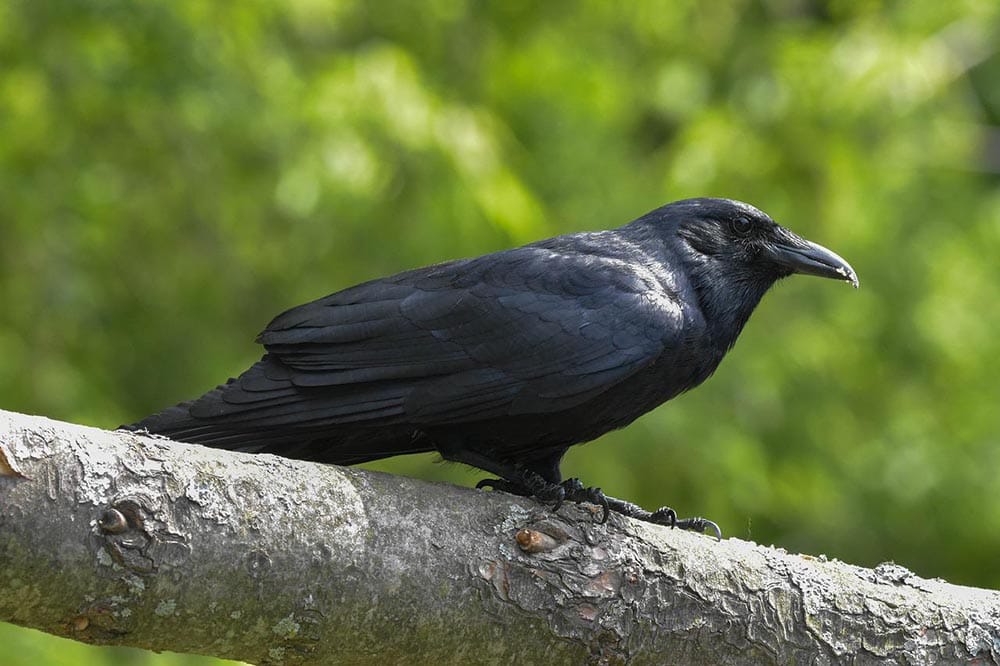
| Scientific Name: | Corvus brachyrhynchos |
| Average Brood Size: | 4 to 6 eggs |
The American crow has a fitting name and is present at least part of the year in all 48 contiguous states. In Wisconsin, the crow has a year-round presence. Like the common raven, it belongs to the crow, magpie, and jay family. The bird avoids hot desert areas but can adapt to almost any other environment.
You’re just as likely to see a crow in a Milwaukee park as you are in open farmland near Eau Claire. American crows are not picky eaters; they dine on garbage, insects, carrion, and even other birds’ eggs. The crows have a unique family structure. A mated pair’s older offspring often return to them during the summer. These older sibling birds help feed the current year’s nestlings.
13. Double-Crested Cormorant

| Scientific Name: | Nannopterum auritum |
| Average Clutch Size: | 3 to 4 eggs |
As the name suggests, the double-crested cormorant belongs to the cormorant family. You can spot the birds near any body of water. They breed in the northern two-thirds of the state and migrate to the Gulf Coast during the winter. Rarely do cormorants spend the winter in the southern half of Wisconsin.
Bird experts study cormorants in the Apostle Islands, where annual breeding surveys occur. The birds are primarily omnivores that eat aquatic animals but will eat some plant material. Young birds wander from the nest as early as 1 month old but return to eat.
14. European Starling

| Scientific Name: | Sturnus vulgaris |
| Average Clutch Size: | 4 to 6 eggs |
European starlings are the only birds on our list that are not native to North America. A group of 100 birds was released in Central Park in the 1890s. These adaptable birds now live on most of the continent, from southern Alaska to northern Mexico. Birdwatchers in Wisconsin will see the birds all year.
They are not picky eaters and will dine on insects, birds, seeds, and nectar. Many regard European starlings as pests. They overtake other species’ nesting areas and can mimic other birds’ songs. The male builds the nest until the female comes along and takes over. In a comical exchange, the females often “redo” the work of the males and throw out some of his building material. Young birds stick around for three weeks before leaving the nest.

Wisconsin Blackbirds FAQs
Do you have questions about blackbirds? Learn more in our FAQs below.
Do Blackbirds Remember Humans?
Blackbirds remembering people is more than folklore. One study revealed that ravens, in particular, do recognize and remember humans. The birds participated in an experiment where there were “fair” and “unfair” trainers. Someone would hand a raven a piece of bread, which the bird would then bring to a “fair” trainer. The “fair” trainer would take the piece of bread from the bird and then offer it a piece of cheese as a reward.
The second phase of the experiment involved “unfair” trainers who would take the piece of bread from the bird but then eat the cheese themselves. The ravens remembered who gave them cheese and who didn’t. Later, when given a choice between bringing the bread to a “fair” trainer or an “unfair” trainer, the majority of the birds chose a “fair” trainer.
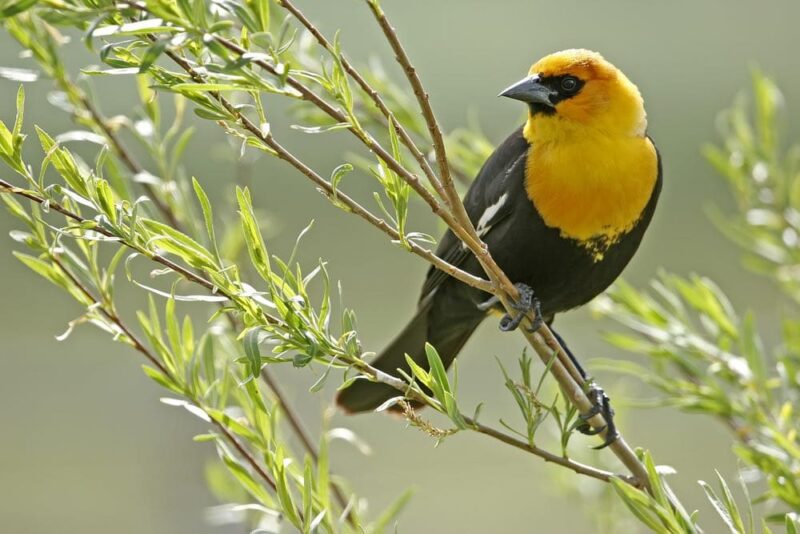
What Does It Mean When a Blackbird Visits You?
That depends on who you ask! There are countless legends and folk tales about blackbirds. Some involve real-life encounters with blackbirds, while others say that dreams about blackbirds carry symbolism. Within these stories, the meaning of a blackbird’s visit ranges from ominous to spiritual.
We’ll wager that a blackbird sighting simply means spring is coming.
What Do Blackbirds Like to Eat?
Many of the birds on our list feast on insects during the warmer months. You can help preserve their diet by not using insecticides on your lawn. The birds will take of the insects for free!
The few blackbirds that stay in Wisconsin during the winter will appreciate a stocked bird feeder. Look for a seed blend formulated for blackbirds, or a mix that contains seeds, insects, and berries.

Final Thoughts
Our list of Wisconsin birds is split into two categories: birds that belong to the blackbird family and those that belong to other bird families but are predominantly black in color.
Many of the birds come to Wisconsin to breed, then fly south for the winter. The opposite is true for the rusty blackbird. They breed in Alaska and Canada but occasionally come to Wisconsin for the winter. The one bird on our list that is not a welcome sight is the brown-headed cowbird. They are brood parasites and threaten other species’ populations.
Featured Image Credit: JackBulmer, Pixabay
About the Author Robert Sparks
Robert’s obsession with all things optical started early in life, when his optician father would bring home prototypes for Robert to play with. Nowadays, Robert is dedicated to helping others find the right optics for their needs. His hobbies include astronomy, astrophysics, and model building. Originally from Newark, NJ, he resides in Santa Fe, New Mexico, where the nighttime skies are filled with glittering stars.
Related Articles:
Monocular vs Telescope: Differences Explained (With Pictures)
How to Clean a Refractor Telescope: Step-by-Step Guide
How to Clean a Telescope Eyepiece: Step-by-Step Guide
How to Clean a Rifle Scope: 8 Expert Tips
What Is a Monocular Used For? 8 Common Functions
How to Clean a Telescope Mirror: 8 Expert Tips
Brightfield vs Phase Contrast Microscopy: The Differences Explained
SkyCamHD Drone Review: Pros, Cons, FAQ, & Verdict
